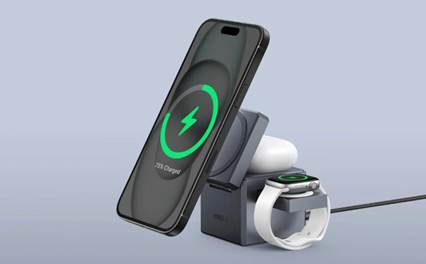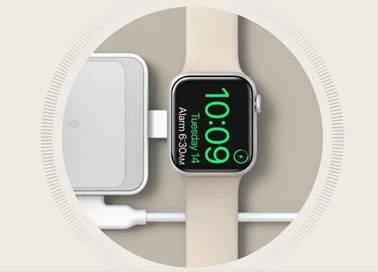Wireless charging has
grown in popularity, transforming how we power our smartphones. This cable-free
innovation eliminates the hassle of cords, offering convenience and ease. With
major smartphone brands adopting this feature, many wonder: Is wireless
charging the future? To answer this, we must explore how the technology works,
its benefits, and its drawbacks. While wireless charging offers reduced wear on
ports and a sleek user experience, it also faces hurdles like slower charging
speeds and inconsistent device compatibility. Understanding these aspects helps
us predict how future innovations may improve wireless charging and determine
whether it will truly replace wired methods.

Understanding Wireless Charging
Technology
How
Wireless Charging Works
Wireless charging, also known as
inductive charging, operates on the principle of electromagnetic induction. A
wireless charger creates an electromagnetic field through a coil, and when a
compatible device is placed on or near the charger, it induces an electric
current in the device’s coil, thereby transferring energy without the need for
a physical connection. This process eliminates the necessity of plugging a
cable directly into the device, facilitating a more seamless charging
experience.
Evolution of Wireless Charging
Standards
The evolution of wireless charging
standards has seen significant advancements. Initially, the Qi standard,
developed by the Wireless Power Consortium (WPC), set the groundwork for
widespread adoption. Over time, other standards like PMA (Power Matters Alliance)
emerged, but the Qi standard ultimately became the most widely accepted. The
continuous refinement of these standards has led to improved efficiency and
compatibility across a broad range of devices.
Adoption by Major Smartphone
Manufacturers
Major smartphone manufacturers have
increasingly embraced wireless charging technology. Many companies have integrated wireless
charging capabilities into their flagship devices, making it a standard feature
rather than a luxury. This widespread adoption has paved the way for wireless
charging to become more mainstream, influencing the development of
complementary technologies and infrastructure.
Advantages of Wireless Charging
Convenience
and Ease of Use
One of the most compelling
advantages of wireless charging is its sheer convenience. Users can simply
place their phones on a charging pad without worrying about plugging in cables
or dealing with tangled cords. This ease of use is particularly beneficial in
environments where quick, frequent access to the device is required, such as
workplaces or homes.
Reduced
Wear on Charging Ports
Frequent plugging and unplugging of
charging cables can lead to wear and tear on the charging ports of smartphones
over time. Wireless charging eliminates this physical connection, thereby
reducing the mechanical strain and extending the longevity of the device’s
ports. This benefit is particularly significant for users who charge their
devices multiple times a day.
Integration into Public Spaces and
Furniture
The integration of wireless
charging technology into public spaces and furniture has also contributed to
its growing popularity. Many cafes, airports, hotels, and even cars now feature
built-in wireless charging stations, making it more convenient for users to
charge their devices on the go. Additionally, furniture manufacturers are
incorporating wireless charging pads into desks, tables, and other pieces,
enhancing the functionality and appeal of their products.
Challenges and Limitations
Slower Charging Speeds Compared to
Wired Methods
One of the primary criticisms of
wireless charging is that it often delivers power at slower rates than direct
wired connections. While wireless technology has improved, wired charging
remains faster and more efficient, especially with advancements like fast-charging
cables. Users who need a quick power boost may find wireless charging less
practical in time-sensitive situations.
Energy
Efficiency Concerns
While wireless charging is
convenient, it raises concerns about energy efficiency. The process of
transmitting energy wirelessly is inherently less efficient than wired
charging, with some energy lost in the form of heat. This inefficiency not only
affects charging times but also leads to increased energy consumption.
Addressing these concerns is crucial for the widespread adoption and
sustainability of wireless charging.
Compatibility Issues Across Devices
Compatibility remains a significant
challenge in the wireless charging ecosystem. Not all devices are compatible
with all chargers, and variations in standards can lead to confusion among
consumers. Even among iphone chargers, differences in
implementation—despite the dominance of the Qi standard—can result in
inconsistent charging experiences. Standardization and interoperability are
vital to ensuring a seamless user experience.

Future Prospects and Innovations
Development of Long-Range Wireless
Charging
One of the most exciting prospects
for wireless charging is the development of long-range wireless charging
technologies. Companies are exploring methods to charge devices from a distance,
eliminating the need for physical contact with a charging pad. Technologies
like resonant inductive coupling and radio frequency (RF) charging are being
researched to extend the range and efficiency of wireless power transmission.
Advancements in Fast Wireless Charging
Advancements in fast wireless
charging are also on the horizon. Researchers and manufacturers are working on
improving the power delivery capabilities of wireless chargers, aiming to match
or even surpass the speeds of wired fast chargers. Innovations such as higher
frequency wireless power transfer and better heat management techniques are
crucial to achieving these goals.
Potential for Universal Standards
The potential for creating
universal standards in wireless charging is another area of significant
interest. Establishing a single, cohesive standard that all devices and
chargers adhere to would simplify the user experience and drive adoption.
Universal standards would ensure compatibility across different brands and
devices, making wireless charging more accessible and reliable for consumers
worldwide.
Conclusion
The future of smartphones is closely tied to the
evolution of wireless charging. This technology brings convenience, less wear
on ports, and seamless integration into homes and vehicles. However, it still
faces hurdles like slower speeds, energy loss, and limited device
compatibility. Innovations in fast and long-range wireless charging, along with
emerging universal standards, are gradually addressing these concerns. As the
technology matures, wireless charging is shifting from a premium feature to a practical
necessity. It marks a move toward more sustainable, user-friendly power
solutions, positioning itself as a vital part of how we’ll charge our
smartphones and even complement iPhone chargers in the near future.
